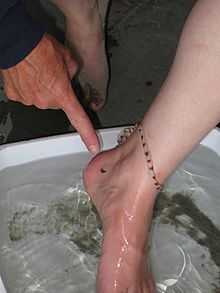Stingray injury
Stingray injuries are caused by the venomous tail spines or stingers of rays in the order Myliobatiformes, most significantly those belonging to the families Dasyatidae, Urotrygonidae, Urolophidae, and Potamotrygonidae. Stingrays generally do not attack aggressively or even actively defend themselves. When threatened, their primary reaction is to swim away. However, when attacked by predators or stepped on, the stinger in their tail is whipped up. This is normally ineffective against sharks, their main predator.[1]
Depending on the size of the stingray, humans are usually stung in the lower limb region.[2] Stings usually occur when swimmers or divers accidentally step on a stingray,[3] but a human is less likely to be stung by simply brushing against the stinger. Surfers and those who enter waters with large populations of stingrays have learned to slide their feet through the sand rather than taking steps, as the rays detect this and swim away, as will stamping on the bottom as one treads through murky water. .[4] The stinger usually breaks off in the wound.[3] This is not fatal to the stingray as it will be regrown at a rate of about 1.25 to 2 centimetres (0.49 to 0.79 in) per month (though with significant variations depending on the size of the stingray and the exact species). Contact with the stinger causes local trauma (from the cut itself), pain, swelling, and muscle cramps from the venom, and possible later infection from bacteria [3] or fungi.[5] Immediate injuries to humans include, but are not limited to: poisoning, punctures, severed arteries and veins, and occasionally death.[6][7] [8] Fatal stings are very rare, but can happen,[3] famously including Steve Irwin. In this case, the stinger penetrated the thoracic wall, causing massive trauma.[9]
Biological structure of the barb
The barb is covered with rows of sharp flat spines, composed of vasodentin. Vasodentin is an incredibly strong cartilaginous material which can easily cut through flesh. The undersides of the spines contain two longitudinal grooves which run along the length of the spine and enclose venom-secreting cells. Both the venom-secreting tissues and vasodentin are enveloped in an epidermis that tears open when the barb is plunged into a victim. Some spines may break off as the barb exits the wound and stay within the victim causing prolonged envenoming.
Sting
Many victims of stingray related injuries suffer from physical effects including nausea, vomiting, diarrhea, extreme pain at the wound, muscle cramps, and a laceration at the puncture site. There have been cases of severe consequences which may include embedded spines, infection, hypotension, and even possible amputations or death.[10][11] Stingray wounds have also been found to bleed profusely and for a long amount of time after the initial puncture. It has been suggested that there may be some sort of anti-haemoglobin agent incorporated with the secreted venom, but Professor James H. Diaz of Louisiana State University has refuted that theory.[12]
Treatment

Treatment for stings may include application of hot water (optimum temperature is 45 °C (113 °F), taking care not to cause burns),[3] which can help ease pain by denaturing the complex venom protein. Antibiotics may be administered to prevent infection if there is a delay in treatment, if the wound is deep, or if there is a large amount of foreign material in the wound.[3] Immediate injection of a local anesthetic in and around the wound, or a regional nerve blockade, can be helpful, as can the use of parenteral opiates such as intramuscular pethidine.[3] Local anesthetic may bring almost instant relief for several hours. Vinegar and papain are ineffective. Pain normally lasts up to 48 hours, but is most severe in the first 30–60 minutes and may be accompanied by nausea, fatigue, spreading cramps, headaches, fever, and chills. All stingray injuries should be medically assessed;[3] the wound must be thoroughly cleaned, and surgical exploration is often required to remove any barb fragments remaining in the wound. Following cleaning, an ultrasound is helpful to confirm removal of all the barb fragments.[13] Not all remnants are radio-opaque; x-ray radiography imaging may be helpful where ultrasound is not available.[3]
See also
- Snake bite
- Skin lesion
- Steve Irwin
- Findlay E. Russell
- Odysseus Acanthoplex
References
- ↑ "Stingray City - About Stingrays". Caribbean Magazine.
- ↑ DuBois, David MD, MS, FAAEM, FACEP (2012). "Stingray Injury". WebMD. Retrieved 23 July 2012.
People who step on a stingray most frequently are injured on their feet and lower legs.
- ↑ 3.0 3.1 3.2 3.3 3.4 3.5 3.6 3.7 3.8 Slaughter RJ, Beasley DM, Lambie BS, Schep LJ (2009). "New Zealand's venomous creatures". N Z Med J 122 (1290): 83–97. PMID 19319171.
- ↑ http://uk.news.yahoo.com/5/20091116/twl-croc-hunter-s-widow-blamed-for-bushf-3fd0ae9.html
- ↑ "Stingray Injury Case Reports". Clinical Toxicology Resources. University of Adelaide. Retrieved 22 October 2012.
- ↑ Taylor, G. (2000). "Toxic fish spine injury: Lessons from 11 years experience.". South Pacific Underwater Medicine Society Journal 30 (1). ISSN 0813-1988. OCLC 16986801. Archived from the original on 2010-04-16. Retrieved 2008-06-15.
- ↑ "Stingray Injury to the Webspace of the Foot | Orthopedics". Healio.com. Retrieved 2014-03-10.
- ↑ "Two Cases of Fatal Necrotizing Fasciitis Caused by Photobacterium damsela in Japan". Ncbi.nlm.nih.gov. Retrieved 2014-03-10.
- ↑ Crocodile Hunter (2012-05-30). "Discovery Channel Mourns the Death of Steve Irwin". Animal.discovery.com. Retrieved 2014-03-10.
- ↑ Hamid Rajainan, Javid Sajedianfard, Paria Parto. “Study of patient's injuries by stingrays, lethal activity determination and cardiac effects induced by Himantura gerrardi venom.” p. 881-886.
- ↑ "File:Stingray attack 1953.jpg - Wikipedia, the free encyclopedia". En.wikipedia.org. Retrieved 2014-03-10.
- ↑ Diaz, James H. “Evaluation, Management, And Prevention of Stingray Injuries In Travelers.” p. 102-109.
- ↑ Flint D, Sugrue W (1999). "Stingray injuries: a lesson in debridement". N Z Med J 112 (1086): 137–8. PMID 10340692.
| ||||||||||||||||||||||||